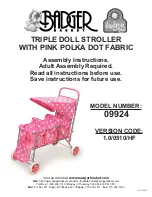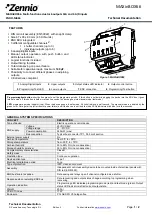
10
strollers, which public transport operators are obliged to provide.
18.
The safety instructions in this manual do not cover all possible conditions and unforese-
eable situations which may occur. It must be understood that common sense, caution and
care are factors that cannot be built into a product. These factors are the respo sibility of
the carer using the stroller.Follow the recommendations and instructions regarding safe
transport of children in strollers, which public transport operators are obliged to provide.
19.
The safety instructions in this manual do not cover all possible conditions and unfo-
reseeable situations which may occur. It must be understood that common sense,
caution and care are factors that cannot be built into a product.
20.
These factors are the responsibility of the carer using the stroller.
21.
This product should not be used as a medical treatment device. If your child has
special health needs relating to transport, you should consult your doctor.
22.
Do not modify this product as it may compromise the safety of your child. The manu-
facturer is not liable for any modifications to the product.
23.
Crossing train/tramway rails can pose a particular threat because the wheels of the
stroller can get stuck in them. We recommend locking the swivel wheels. Be cautious.
24.
Make sure child is kept clear of all moving parts (e.g. wheels) risk of injury.
25.
Remember that at underground or train stations sudden pressure changes in the air may
occur. When close to platform edge make sure you hold the handle with both hands as
the applied braking device may not be sable to keep the stroller safely in place.
26.
Never park the stroller on a hill, uneven or slippery surface.
27.
Do not stand or sit the child on the footrest. The footrest is designed to support legs
and feet of one child only. Any other usage may lead to serious personal injury. The
maximum load for the footrest is 3 kg.
28.
Always remove the child before folding the stroller.
29.
The stroller is designed to transport one child who can sit up unassisted (over 6
months). Maximum weight of the child: 15 kg.
30.
The parking device should be engaged when child is being placed in or removed
from the stroller.
31.
Use only replacement parts supplied or recommended by the manufacturer/distributor.
32.
Keep plastic packaging materials out of reach of children to avoid the danger of suffocation.
33.
When parking always use the parking brake.
34.
Avoid situations of extreme use which reduce your control over the child and the stroller.
35.
Do not carry a child in a stroller.
36.
Make sure that the child’s hands stay clear of possible pinching areas when the
stroller or its parts are being folded, unfolded, changed or adjusted.
37.
When transporting the stroller in a car trunk make sure that the trunk lid does not
exert pressure on the product as this may damage the stroller.
38.
Remember that small parts, such as the caps protecting axles in transport, can be
swallowed by your child, and may cause your child to choke.
39.
Appropriate air pressure in the wheels ensures correct shock absorption.
40.
Minimum air pressure - 0.8 atm. Maximum air pressure must not exceed 1.5 atm.
41.
Keep correct pressure (about 1 ÷ 1.2 atm) in the wheels to ensure proper maneuve-
ring of the vehicle.
42.
The travel system car seat does not replace a carrycot or bed. Your child
needs sleep, in consequence, after a walk outside, they should be placed in a carry-
cot, bed or cot. Please keep the time of the child in a car seat to a minimum.
MAINTENANCE:
Stroller should be cleaned with a soft cloth after use in wet weather. Clean the wheels
and metal parts using only a mild detergent and warm water. Periodically lubricate the
moving parts of the vehicle, especially axles steering wheels to ensure its smooth func-
tioning. Upholstery and shopping basket are not machine washable. Do not overexpose
the stroller to sunlight. For safety reasons use original parts only.
ENGLISH













































